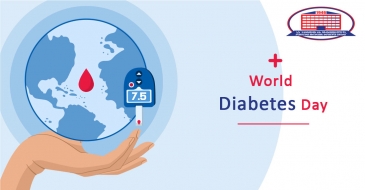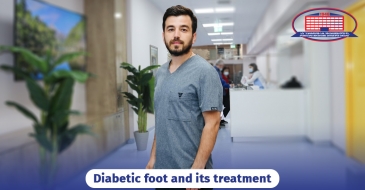Numbness of limbs is a very common symptom.
Often the numbness of limbs indicates nerve irritation; although this symptom may also indicate variety of diseases, For example:
- Diabetes;
- Blood insufficiency;
- Nerve compression;
- Nerve inflammation;
- Neuropathy;
- Nerve damage;
- Impact of toxic substances;
- Medication reaction;
- Thyroid gland problem;
- Insufficient blood flow to corresponding parts of the human brain
- Stroke
National Center of Surgery’s vascular surgeon, Levan Gogliashvili discusses numbness of limbs with us.
Surgeon States - "The numbness of limbs does not always indicate disease. For example, when we sit still in an uncomfortable position for a long time or have our legs crossed, we may feel numbness in limbs that can last 1 minute or more – this does not indicate pathology. In both cases we are dealing with nerve irritation.
In the first case, the condition is caused by a nerve compression, and in the second case -reduced blood flow. In both cases, the sense of numbness quickly disappears and, therefore, it does not present a danger. It should be noted, that in practice we mostly encounter diabetic neuropathy, nerve compression and blood insufficiency (chronic arterial insufficiency, atherosclerosis). Each one of them presents a serious pathology that requires multi-sided approaches in order to perform diagnostic procedures and determine treatment tactics on time.
–Mr. Gogliashvili, what causes pain in the lower limbs and when should we visit a doctor?
-Pain is a defense reaction, sensory or unpleasant feeling that emerges during expected or existing damage to the tissue. Pain is an actual problem. According to recent medical literature data, 20% of adults in the world suffer from pain, and one out of 10 is annually diagnosed with chronic pain. There are many serious complications accompanying chronic pain syndrome such as depression, insomnia (sleep regime disturbance at night), movement restriction, mood disorder, anorexia (lack of appetite), asthenia (general weakness), labour failure, cutting off social ties and isolation from society. Therefore, I think, in case of pains, the patient should visit the appropriate specialist, in order to perform early diagnostic procedures and treatment. I would point out several cases of pain that require immediate visit to the doctor: pain, accompanied by the limbs’ skin paleness, blueness or blackness. Also, pain in lower limbs caused by walking 200 m or pain caused by being in a resting position that ceases after lowering limbs. When it comes to diabetic patients, any unpleasant sensation in lower limbs is quite alarming and important. Be it numbness, burning sensation, itchiness or pain. This contingent requires special attention in this sense, because impaired sensibility in diabetic patients might result in patients not being able to sense serious damages - contact your doctor during any unpleasant sensation.
–Pain in lower limbs indicates which diseases?
-Pain etiology is diverse but it is important to distinguish atherosclerosis and diabetes that may lead to gangrene development. Also, nerve inflammation and nerve compression from the spine to toes. For an instance, herniated disk and baker cyst. Latter is a growth in a popliteal fossa that puts pressure on an important structures and is caused by arthritis. Also, joint pain in case of rheumatic arthritis and etc.
–Patients often have complaints regarding lower limbs swelling. What causes this condition?
-Swelling in the lower limbs is a fluid accumulation in the limb tissue and cellular space, the cause of which is most often heart failure, chronic and acute insufficiency of the veins of the lower limbs – in other words thrombosis, and then renal insufficiency, hepatic insufficiency, lymphatic system pathologies and more. Of course, I focus on diseases and chronic venous insufficiency in the lower limbs.
For example, according to the research vein consult program, out of 91,000 people 63,900 had chronic venous disease symptoms. Chronic venous disease and insufficiency lead to quality of life deterioration and is associated with big expanses. As for the mechanism, during this time direction of blood flow is disturbed. To explain it further, in a physiological condition blood flows from lower limbs towards the heart and so called valves prevent the backflow of blood, because we stand upright and blood constantly pushes veins down from the top .
When the vein wall is damaged, pressure increases in the vein, valve is deteriorated, and damaged valves cannot prevent backflow of blood, it flows towards the lower limbs, causing swelling, pain, itching, burning, and difficulty in movement.
The varicose degeneration of the veins occurs and there’s a possibility of thrombosis in damaged veins. Thrombosis might migrate in deep veins (in 6-44%) and cause an extremely dangerous complication- Pulmonary thromboembolism that occurs without symptoms in 20-33% of the cases and with symptoms in 2-13% of the cases. Thromboembolism complication requires a resuscitation measures and in often might result in death. That’s why timely diagnostics and treatment is necessary.
–Mainly which gender and age group of people have complaints regarding lower limb pains and why?
- Generally, it is very difficult to differentiate between genders and state in which one the disease symptom expresses itself more. Nevertheless, if we take specific diseases, for an instance, chronic venous disease, lymphostasis – it’s more common in women; atherosclerosis - in men, diabetic neuropathy - statistically equal in both and so on.
–What can you tell us about lower limb pain cause’s diagnostics and treatment methods in National Center of Surgery?
–The National Center of Surgery is a multi-profile clinic equipped with modern equipment and highly qualified doctors. In case of lower limb pains, National Center of Surgery offers patient a multi-profiled approach so called limb rescue path. It does not matter which pathology caused a complaint. We will examine, diagnose and offer relevant conservative or surgical treatment. For example, in case of varicose disease, lower limb duplex scan is performed. The cause, level and quality of pathology is determined and so called bloodless operation – endovenous laser ablation is planned. During this operation closure of damaged venous stem is carried out by a special laser beam, after which patient leaves the operation room on his feet and returns home after few hours. Often only with this type of intervention, it’s possible to create proper environment for a tropic ulcer to heal.
To prevent gangrene development, blood supply quality is determined by Ankle Brachial Index, followed by digital angiography or computed angiography, where the location and percentage of reduced blood vessel is visible and endovascular surgery is performed.
In most cases, this manipulation only consists of a prick in the upper limbs, elbow joint or anat groin area. Narrowed areas are expanded and a stent - special carcass is placed there, also recanalization of completely clogged arteries takes places with special wires or hybrid operation, during which small section of thrombus or atherosclerotic plague is removed from anat groin area, narrowed area is expanded and stent is placed there. After couple of days, patient returns home and is on register list at our clinic.
National Center of Surgery address: Tbilisi, Dighomi, Chachava N5.
You may contact National Center of Surgery call center at 577 119 119 or 02 25 25.
In case of any issues, you may contact vascular surgeon, Levan Gogliashvils for consultation at 596 90 96 96
Wish you health!








